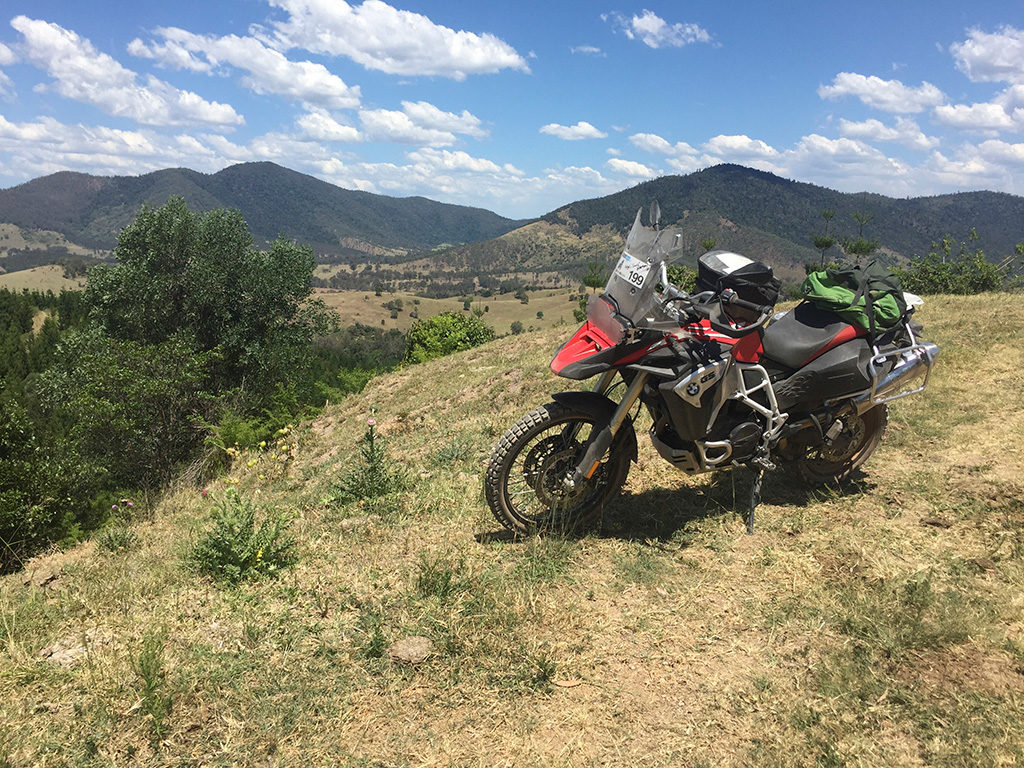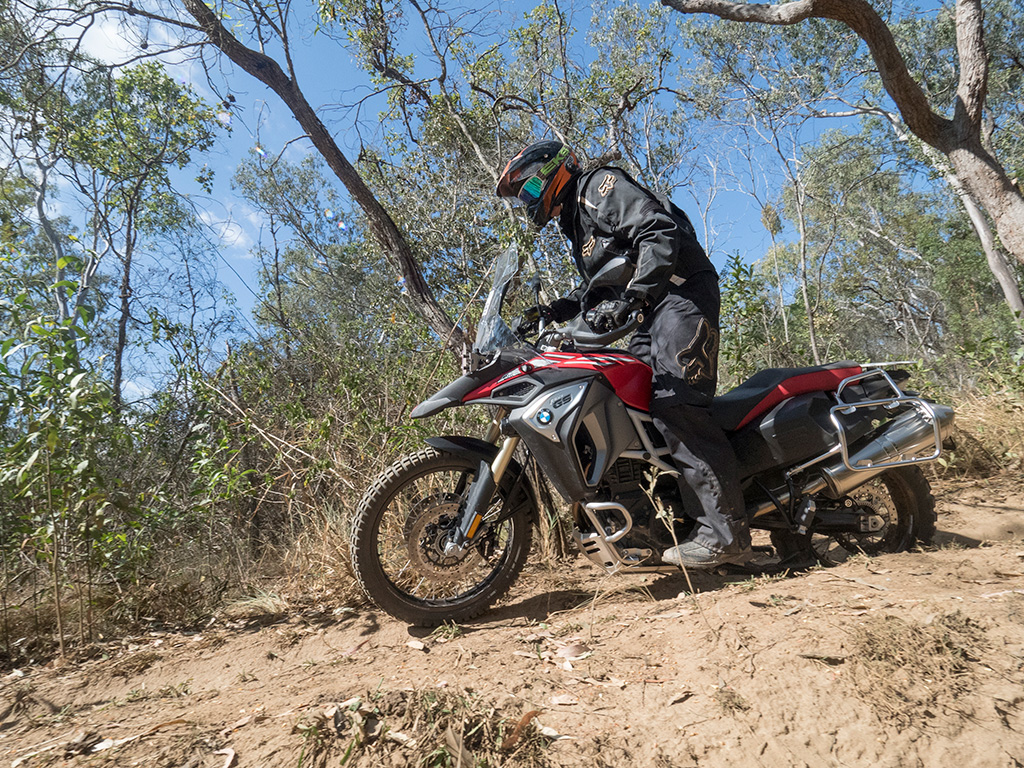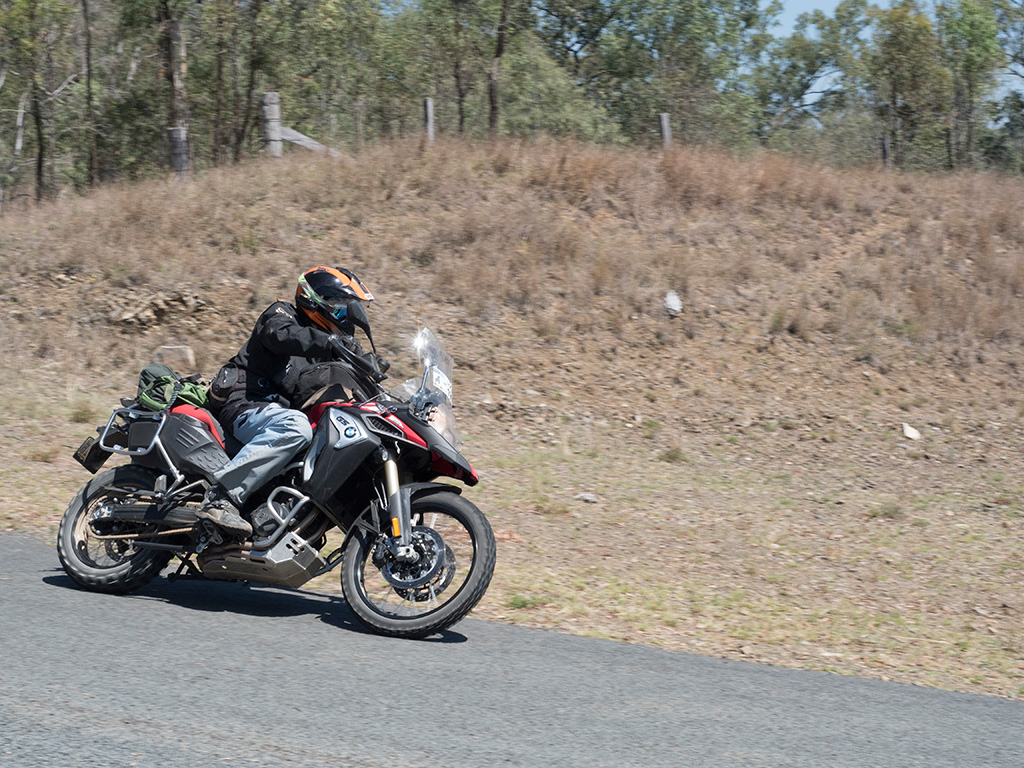THE BMW F 800 GS Adventure has always been the little brother who could. It’s smaller, not as brawny, but just as tough and capable as the more famous family member, the R 1200 GS Adventure.

While all the GS models are enjoying popularity among Australia’s motorcyclists, it’s the R 1200s which are rolling out of showrooms the most, and for good reasons – they are incredible machines, being highly capable, versatile, powerful and tough.
They are also expensive, heavy and bulky, which is why BMW also has the F 800 GS and F 800 GS Adventure in the range, and if you don’t think that’s important you’re probably not a dirt bike rider.
The tighter the terrain, the lighter you want your bike. Riders who seek-out single-track trails running up and down mountains, through creeks and rivers, over rocky terrain and through mud know a lighter bike will be easier to handle, more likely to get through and even suffer less punctures then a heavier bike. You’ll end up less fatigued and beaten-up at the end of a long day of riding, too.
It’s the same at the heavy-end of off-road riding with twin-cylinder Adventure bikes. There are no truly lightweight Adventure twins, but backing up each day of the recent GS Safari (see the Jan/Feb issue) in the intense heat of a Queensland summer just felt that much easier than if I’d been riding the behemoth of the Adventure world, the R 1200 GS Adventure.
In comparison, the F 800 GS Adventure feels lithe. It’s a physically smaller machine overall, but still plenty roomy enough for a 185cm rider. Narrower and shorter too, the F 800 GS is less intimidating and easier to ride than its big brothers.
2017 changes
For 2017 BMW has altered the electronics package of the small GS machines and altered the riding modes. There’s Rain, Road, Enduro and Enduro Pro if you choose the right options (make sure you buy the optional Dynamic Package) and jump through the right hoops, but boy, is it worth it. But more on that later.
The Dynamic Package also adds ESA (Electronic suspension Adjustment), ASC, (Automatic Stability Control, aka traction control. There’s an ‘electromotive’ throttle controller… which most of us would call ride-by-wire (so no throttle cable, just an electronic signal from the twist grip sensor to motorcycles engine control unit).
Along with the new modes and throttle there are new instruments.
The exhaust system has been updated, and BMW is offering an Akrapovi? system for the bike, too. The new pipe is a result of updating the bike for Euro4 emission regulations, so you can feel that little bit greener when you ride one, too.
There’s also galvanised radiator trim and integrated GS badges.
Two new colour schemes are available in 2017:
Racing Red, light while frame, white shock spring, red/black seat, tinted windshield; and Catalano Grey metallic paint, black frame, white spring, grey/black seat.
I thought there was a third colour, Mud Brown: paint, seat, frame, wheels and everything else, but I discovered later (with the aid of a pressure washer) it was actually a red one until Adventure Rider’s Tom Foster had been let-loose on the bike in the days before it was handed over to me. Some excuse about ‘rain’, ‘mud’, and ‘just because’…
The powerplant
There’s 63kW (85HP) available at 7500rpm and 83Nm at 5750rpm. The power is delivered in a surprisingly steep power curve, but there’s more than 50kW from about 5700rpm, so it’ll pull if you rev it. More importantly on a bike of this type is the 75Nm-plus being produced from 3500rpm – torque which will get you out of trouble, covers up your mistakes and makes the bike easy to ride fast.
It’s all produced by a 798cc parallel twin. The 82mm bore and 75.6mm stroke make it only moderately over-square, which explains the low revs and high torque, by modern standards.
It’s water-cooled, has four valves per cylinder, double overhead camshafts has a wet clutch and six-speed gearbox before driving the rear wheel with a chain.
Now, I love the R-series twins, but I like the wet clutch and chain drive of the 800s. The smaller twins have slicker shifting, freer-spinning motors and no side-to-side shake, making them feel far more conventional than the horizontally-opposed engines. Not better mind you, different, and you need to know that.
If you’re seriously considering a BMW 800 you’re not looking for the last word in performance, but you’ll get a very capable machine. It’s not the fastest, lightest or highest-performing adventure bike on the market, but it will hold its own on a decent ride.
Getting it dirty again…
The bulk of my riding on the 2017 800 was done on dirt roads: that’s the nature of the GS Safari where the bike was launched, and I loved it (see the Jan/Feb 2017 issue for the story of the GS Safari).
If the bike’s dimensions have changed I didn’t notice it – throw a leg over the bike and it feels very much like the earlier model. There’s still the excellent triple-row footpegs (which owners of standard GSs should fit, the double row pegs are awful), flip-down brake height adjuster, 24-litre fuel tank under the seat, crash bars & pannier rails and protective screen.
Upfront is a 21-inch front wheel. That’s a serious off-road size and is something I really like to see on a bike designed to travel on dirt roads as much as bitumen. BMW had fitted Continental knobbies to the bike for the Safari (they are an option) which are a fantastic tyre, but boy do there wear out quick when the weather is hot and the riding spirited.
On the road the 21-inch tyre, especially with the knobby, really doesn’t offer the performance or confidence of the fat 19-incher on the 1200cc models. Not that the 800 is bad, it’s really a case of the 1200s being amazing…
The seat height is excellent for bean-poles like me, although obviously those of shorter stature might not appreciate it being up there at 890mm. BMW offers a low suspension option of 860mm, and you’ll have to make up your own mind about doing that – I reckon it might compromise the suspension performance somewhat, but I also suppose you’ll have to stop and put your feet on the ground before too long.
The modes
The electronic wizardry integrates throttle position, engine speed, gear, ABS, ASC and more. The system uses information from all these systems to determine how hard the bike will accelerate, what the suspension is doing and lots more.
From the user’s perspective, there are just a handful of choices to be made and the bike will do the rest.
“Rain” mode is designed for wet sealed surfaces and gives a very gentle throttle response while ABS and ASC will kick in with little provocation – which is what most of us want in the wet. The launch was run in very hot and dry conditions – so the tyres barely got wet, so I’m unable to report on rain mode. But I’m sure it would be fine.
How BMW decide what is ‘optimum’ is a mystery, but that’s the throttle response when the bike is set to “Road” mode. ABS and ASC are set up for dry street riding.
“Enduro” mode is designed for the standard road/trail tyres handling light off-road use. Throttle response is gentle, ABS and ASC configured not to cut in too soon. I thought I liked Enduro mode, right up until I tried Enduro Pro… If you have little experience on loose surfaces, Enduro mode is great.
Enduro Pro is the place to be. Designed for off-road rubber it features a snappier throttle, rear-wheel ABS deactivated, plus non-intrusive ASC. I loved this mode, for there’s still a ‘safety net’ of front-wheel ABS and traction control, but it allows for for more aggressive riding.
Experts can switch off ABS and ASC in any mode.
On tour
Your BMW dealer will happily help you fit an array of luggage options to your F 800 GS Adventure, and all you’ll have to do is hand over your credit card briefly. You can choose between tankbags, seatbags, luggage rolls and, of course, panniers. And if you don’t like the BMW offerings, there’s a load of aftermarket options, too.
Serious adventure riders rarely use hard panniers anymore, they are too easy to break in a small tip-over – you’re better off with soft bags. Luckily, the standard pannier frames make strapping on soft bags easy.
From experience I’d recommend a headlight protector and radiator guard, especially if you’re touring with mates – you know, the people who delight in throwing large amounts of dust, water and the occasional rock at you when in the lead.
With the standard tall screen, wide pegs and big fuel tank, it really comes down to personal preference as to what other accessories and options you might want to choose.
The riding position works really well. On the road you’re sitting up in the breeze a little, but the tall Adventure screen, steering geometry, 21-inch front wheel and knobby tyres all conspired to persuade me that high speeds needed be quite as illegal as I’ve sometimes ridden. Seat comfort is OK, too.
I did miss cruise control when riding the road sections, it’s standard on so many bikes these days it’s very noticeable when not available. Not a big deal on an Adventure bike – using cruise off road is a dumb idea – but nice to have for the blacktop in-between. Bet it’s there on the next big update in a few years’ time.
Suspension, brakes and stuff
It’s got forks, a shock absorber, alloy swingarm and a trellis frame. All good. What, you want to know more? What for? It all works pretty well… The bike I rode was fitted with ESA, Electronic Suspension Adjustment, which performs its magic in the background, adjusting settings on the fly and trying to create a comfortable, confidence-inspiring and good handling ride.
I didn’t fiddle with the suspension much at all on this launch, partly because I was busy riding but mostly because I didn’t need to. Generally I’ll adjust a bike’s suspension until I like it and then leave it alone, but when circumstances change I’m out with the tools again – but not so much with ESA-equipped BMWs. The only manual adjustment is the rear preload – unlike the 1200s, this doesn’t adjust automatically, but the damping rates at the rear does.
I had a couple of big moments on the GS Adventure which the suspension coped with admirably, despite doing my best to throw myself over the handlebars. While not in the league of top-shelf units, the suspension fitted to the 2017 F 800 GS Adventures is well suited to the bike.
Much the same can be said about the brakes. The ABS-equipped triple disc set-up is what we’ve come to expect and it certainly works really well, although I occasionally wonder if a large Supermoto-style single disc would reduce unsprung weight without compromising stopping power… but it doesn’t really matter what I think, I’m sure the BMW marketing team would have heart palpitations if the engineering crew suggested only one disc was required. A lighter front-end might have the GS A handling better over rocky terrain in particular.
Of course most Adventure bikes spend far more time on the bitumen than they do bouncing over rocky trails, and the twin-disc set-up provides excellent stopping power and fade resistance on the tar. The ABS system is tried and true and being able to disconnect the rear ABS to brake slide the rear in Enduro Pro mode is an overdue update.
Conclusion
I’ve been lucky enough to have been a bike journo since the launch of the R1100GS. That bike was impressive, but is was a behemoth of a machine. The 1150s were much the same but with the 1200s BMW managed to shave of quite a bit of weight.
But the F 800s are so much lighter and more compact it’s not funny. If I’m solo and on a loose surface, I’d rather be riding an 800 GS Adventure than any of the 1200s. Two-up and bitumen tends to alter my preferences a little, but in tough conditions the 800s are so much easier to handle and are so much fun to ride I simply love them.
Given the thousands of dollars you can save with an 800 over a 1200 I’m actually surprised more aren’t sold, but then most riders never get the chance to really try out both in similar conditions. If you do get to ride an F 800 GS Adventure on a decent off-road trip, I think you’ll be impressed. n





Be the first to comment